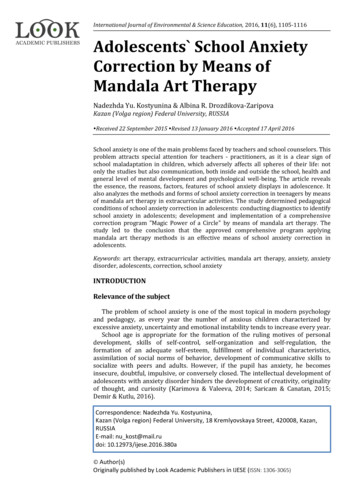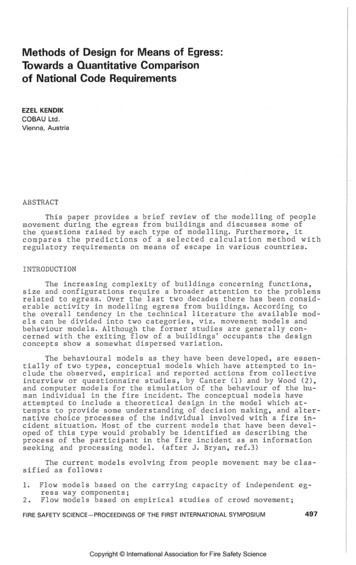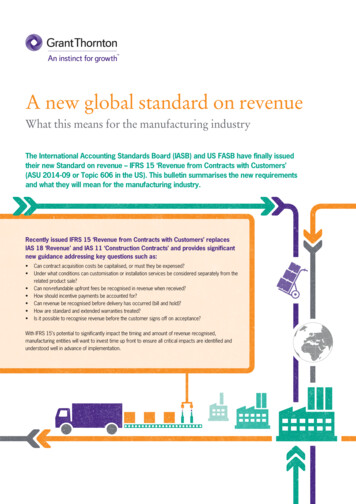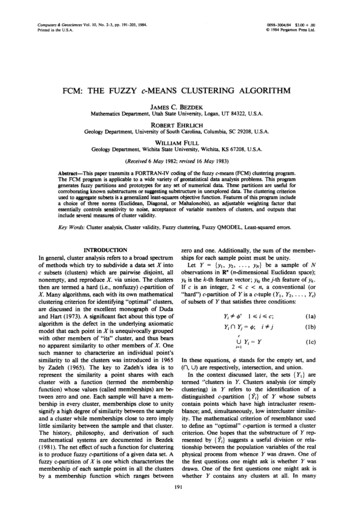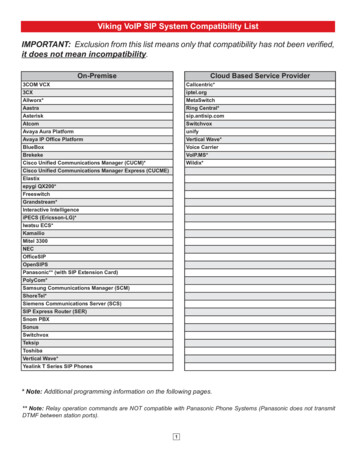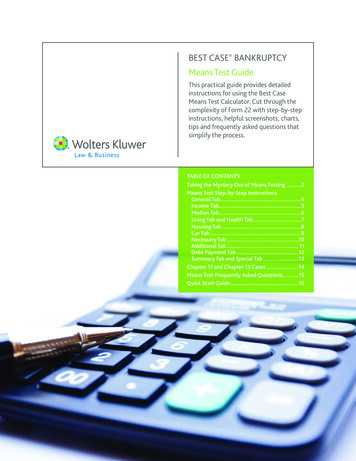
Transcription
BEST CASE BANKRUPTCYMeans Test GuideThis practical guide provides detailedinstructions for using the Best CaseMeans Test Calculator. Cut through thecomplexity of Form 22 with step-by-stepinstructions, helpful screenshots, charts,tips and frequently asked questions thatsimplify the process.TABLE OF CONTENTSTaking the Mystery Out of Means Testing.2Means Test Step-by-Step InstructionsGeneral Tab.4Income Tab.5Median Tab.6Living Tab and Health Tab.7Housing Tab.8Car Tab.9Necessary Tab.10Additional Tab. 11Debt Payment Tab.12Summary Tab and Special Tab.13Chapter 11 and Chapter 13 Cases.14Means Test Frequently Asked Questions.15Quick Start Guide.16
Overview: Taking the Mystery Out of Means TestingThe Means TestImplemented by the Bankruptcy Abuse Prevention and Consumer Protection Act of 2005, the means test is a required form and set of calculationsthat determines whether a presumption of abuse exists for a Chapter 7 debtor in a consumer bankruptcy case. The Means Test, also known as Form22A, is a disposable income formula that measures a debtor’s income against a set of monthly allowances, expenses and debt payments.The Official FormThere are three different forms and means test calculations, based on the chapter of bankruptcy:Chapter 7: Form 22A, Statement of Current Monthly Income and Means Test CalculationChapter 11: Form 22B, Statement of Current Monthly IncomeChapter 13: Form 22C, Statement of Current Monthly Income and Calculation of Commitment Period and Disposable IncomeBest Case Bankruptcy helps you simplify the calculations and minimize errors by providing: A comprehensive calculator with easy on-screen instructions and tabs for each category Charts with Census Bureau Income Data for all states and household sizes Tables with the most up-to-date National and Local IRS Allowances A running tally of the debtor’s income, expenses and disposable income The figure the debtor needs to meet the test A “Wait to File” button that reveals the debtor’s results if he waits to file for bankruptcy And much moreThe Median Income TestThe first portion of the Means Test compares the debtor’s Current Monthly Income (CMI, an average of the last six months, excluding SocialSecurity benefits) to the state median income. If the debtor’s income is less than the median for the debtor’s household size, the full Means Testdoes not apply, and there is no presumption of abuse.The Complete Means TestIf the debtor’s income is higher than the state median, the debtor must complete the full Means Test. The Disposable Monthly Income (DMI) isthen calculated and is based on allowances and actual expenses (see page 3) which are subtracted from a debtor’s current monthly income.Means Test Flow ChartIs the Current Monthly Income Above the State Median Income?YESNOIs DI 7,025 or less?(Current Monthly Income minus Expenses) x 60 Disposable Income (DI)NO 11,725 or more?YESNOYESDoes DI pay at least 25% unsecured debt?YESPresumption of Abuseif filing Chapter 7NONO Presumption of AbuseMeans Test Flow Chart: This is a visual representation of the various stages and calculations of a Chapter 7 Means Test.2Means Testing with Best Case Bankruptcy
Key Word Reference ChartThis chart guides you through the test, identifying where certain items are referenced in the instructions on Form 22A.Note: These are NOT DIRECTIONS. This is simply a list of where items are listed on the form.401(k)Line 26Charitable ContributionsLine 40ChildcareLine 30Debts, BusinessLine 1BDebts, ConsumerLine 1BIRS Standards– Living (Food, Clothingand Other Items)– Health care– Housing– TransportationDebts, Non-PriorityLine 53Life InsuranceLine 27Debts, PriorityLine 44Priority ClaimsLine 44Debts, SecuredLines 20B, 23, 24, 42, 43PensionLine 7Debts, UnsecuredLine 53Real Estate TaxesLine 44Deductions, PayrollLine 26Sales TaxesLine 25EducationLine 29, 30, 38Secured ClaimsLines 20B, 23, 24, 42, 43HealthLines 19B, 31, 34Social SecurityLines 9, 10, 25Health Savings Account (HSA)Lines 31, 34TaxesLine 25IncomeLines 3 to 11TransportationLines 22A, 22B, 23, 24Income (for a business)Line 4UnemploymentLine 9Income TaxLine 25Unsecured ClaimsLine 53InsuranceLines 27, 31, 34, 42UtilitiesLines 20, 37Lines 19A, 39Line 19BLines 20A, 20B, 21Lines 22A, 22B, 23, 24, 37The ExpensesThe DI OutcomeThe Means Test Calculator is organized by Tabs that incorporate thefollowing expenses:If the disposable income exceeds the limits displayed in the charton page 2, then presumption of abuse exists, and you may convert the caseto Chapter 13, or advise your client to file Chapter 13.Living Tab: Applies one IRS Allowance for clothing, food,housekeeping, personal care etc.Jump Buttons Help You Quickly Referto Schedules I and JHealth Tab: Applies IRS Allowances for health care based on age anddebtor’s actual expenses.Housing and Transportation Tabs: Applies the IRS Allowances andthen subtracts any secured payments.The Means Test Calculator contains Jump Buttons in the top right corner,allowing you to view or edit the income listed on Schedule I and expenseslisted on Schedule J. Access these buttons quickly by clicking CTRL ALT INecessary Tab: Requires a debtor’s actual monthly expenses.for Schedule I and CTRL ALT J for Schedule J.Additional Tab: Requires a debtor’s actual monthly expenses forcertain items, some of which have maximum amounts.The Difference Between The Means Testand Schedules I & JDebt Payment Tab: Requires 1) the secured payments contractuallydue in the next 60 months, 2) past due amounts on claims secured byproperty divided by 60, and 3) priority claims divided by 60. ScheduleD and E offer a Means Test Treatment Tab, which allows you to specifypayments and calculate a 60 month average.The concepts of income and expenses for the Means Test differ from theincome and expenses reported on Schedules I and J. Schedule I lists thedebtor’s current income, while the Means Test requires an average fromthe last six months with Social Security Benefits excluded. Likewise, onthe expense side, expense categories are different on the Means Test andSchedule J. Schedule J lists the debtor’s actual current expenses while theMeans Test uses IRS standards for some expenses, and actual for others.Moreover, Schedule J allows the attorney more discretion in listing othertypes of expenses, whereas the Means Test doesn’t allow you to fill inunlimited “other” expenses.After these monthly allowances, payments and expenses arededucted, the Disposable Monthly Income (DMI) is established.Multiply this amount by 60 to determine the Disposable Income thatwould be applied to a hypothetical Chapter 13 Plan for unsecured,non-priority debts.Wolters Kluwer Law & Business www.bestcase.com 1.800.492.80373
Chapter 7 Means Test: Step-by-Step InstructionsDebtor description: The following screenshots show a married couple filing jointly under Chapter 7.To open the means test double click on Form 22A —Statement of Current Monthly Income in the Forms and Schedules menu.General TabStep 1: Indicate Location, Marital Status, Family Size and Household SizeComplete the check boxes with information on the debtor’sfiling status, marital status, family size and household size.Debtor’s Location:The county is populated based on the information provided inthe Voluntary Petition. If this information hasn’t been entered,enter a county now. The debtor’s location determines StateMedian Income, County Housing Allowance and RegionalTransportation Allowance.Exclusion for Disabled Veterans, Non-ConsumerDebts and the National Guard Line 1A: Check to exclude disabled veterans whose debtsaccrued while they were engaged in homeland defense.Line 1B: Check to declare primarily non-consumer debts.Line 1C: Check to declare Reserves and National Guards.If a box is checked, then the box will be checked on theprinted form. The remainder of the test is not necessary.General Tab: Enter marital status and number of dependents.Marital Status: Select the marital status of the debtor to determine if and how the spouse’s income is included. Married filing jointly, both incomes are included. Married not filing jointly, the spouse’s income is not included if the spouse maintains a separate household. Married not filing jointly, without the declaration of separate households, the spouse’s income is included inthe Current Monthly Income, but is only included in the Disposable Monthly Income to the extent that the spouse contributes tohousehold expenses.Household and Family Size: Enter the number of dependents. Based on the number of dependents, thehousehold and family size will be populated. Override options are available for cases where the household size and familysize are not the same. The Household Size determines the comparable median income and health care allowance. The Living Household Size determines the allowable IRS living expenses. The Housing Household Size determines the allowable IRS expenses for housing expenses.Expected Filing Date: The debtor’s expected filing date is used by Best Case for two primary reasons:1. To determine the look-back period for the calculation of CMI.2. To apply the appropriate set of data from the U.S. Trustee (i.e. which IRS allowances, Census Bureau income data,and administrative multipliers apply to the case).Case Number and Filing Date: For cases that have been electronically filed with the Court, Best Case Bankruptcy willautomatically enter the Case Number and Filing Date, pulling this information from the Case Status Tab of the Client Notes section.After entering the appropriate information in each Tab, press [ALT] [N] or click NEXT to continue.4Means Testing with Best Case Bankruptcy
Income TabStep 2: Determine Current Monthly IncomeThe Current Monthly Income (CMI) is the debtor’s averagegross income (before taxes) for the previous six calendarmonths. There are two ways to enter the debtor’s CMI.You can enter the figures directly into the fields on theINCOME TAB, or you may click the CMI DETAILS button todetermine the average income.Income Fields:This is ideal for quickly checking to see if the debtor isabove or below the median, or if the debtor has only oneform of income.Lines 3-10: Enter a debtor’s gross monthly income(averaged over the last six months) into the fields.TIPThe line numbers referenced correspond with line numbers onthe printed form. Print a copy of Form 22 and follow along asyou proceed through the Means Test Calculator.Income Tab: Calculate the debtor’s current monthly income.CMI Details Calculator:This offers an easy way to average the debtor’s income overthe last six months, allowing you to quickly calculate CMI andgenerate an attachment with a complete record of the debtor’sincome sources.Instructions:1. Click CMI DETAILS to open the CMI Calculator.2. Click INSERT to create a new income source:Type: Choose income type from the drop-down menu, whichdetermines where the income is included on the Form.Source: Enter the name of the debtor’s employer whenentering income from a job.Debtor/Spouse: Select whether the income belongs to thedebtor or the debtor’s spouse.CMI Details: Helps you compute the average income over the lastsix months.Method: There are three ways you can calculate theaverage monthly income: 6 Individual Months: Enter the debtor’s income for each of the six months in the look-back period and computean average income based on the monthly totals. Manually enter the income and expenses for each individual month,or if the debtor has several months where the income or expenses are identical, click the COPY AMOUNT DOWN button.Same Income Every Month: If the debtor receives the same amount every month, for example a pension or child supportpayment, enter the regular monthly gross income the debtor receives.Year-to-date Subtraction: With just two or three paystubs, this method calculates the debtor’s average income by takingthe debtor’s year-to-date gross income from the last income statement prior to the start of the CMI look-back period andsubtracting it from the debtor’s year-to-date gross income from the last income statement received during the look-backperiod. If the debtor’s expected filing date is June 30 or earlier, the look-back period extends into the previous year, andthe CMI Calculator will help compute the year-to-date income separately for each year.3. Click the REMARKS TAB to provide details regarding the income source. This is included on the attachment.4. After entering the information, click OK to save changes and return to the main CMI Details screen. Click INSERT to add a newincome source, click CHANGE to edit an existing record. Close to return to the Means Test Calculator.Wolters Kluwer Law & Business www.bestcase.com 1.800.492.80375
Median TabStep 3: Compare the Debtor’s CMI with the State MedianIn most cases, the Means Test ends here. If the debtor’s income falls below the median there is no presumption of abuse, and theapplicable parts of Form 22A will be printed.Line 13 – Debtor’s Annualized Income: The debtor’s annualized income is calculated and the result is displayed.Line 14 – Median Family Income: The Means Test Calculator automatically fills in the State Median, which is determined by thestate of residence and the household size selected in the General Tab. Median incomes are based on Census Bureau numbers; they areadjusted for inflation and published by the U.S. Trustee.!IF THE DEBTOR’S INCOME FALLS BELOW THESTATE MEDIAN, THE TEST ENDS HERE.If the debtor’s income is above the state median, the completion of the Means Test is required. Additional Tabs appear at the top of thescreen to guide you through the calculation of Disposable Monthly Income (DMI).TIPIf the debtor is above the median, enter Schedule D and E claimsto complete Form 22. To save time, complete only the necessaryclaim details—the monthly payment, term, and any past dueamounts.At the bottom of the screen, there is a summary of income andexpenses. This number is updated throughout the means test.TIPClick Wait to File? to see what would happen if the debtor waited1 to 6 months to file. If the debtor is above the state median, thisscreen shows earnings that would be below the state median. If thedebtor is below the state median, the screen reveals the additionalearnings needed to surpass the median.Median Tab: Reveals whether the debtor’s income is above or below thestate median.What is the Marital Adjustment?If the debtor is married, not filing jointly, withoutthe declaration of separate households, there is amarital adjustment to the income. The adjustmentremoves the portion of the spouse’s income notused for household expenses.To calculate the debtor’s marital adjustment, enterthe non-filing spouse’s monthly contribution tohousehold expenses, and the remaining portion ofthe spouse’s income will be removed.6Marital Adjustment: Enter contributions to household expense for thenon-filing spouse.Means Testing with Best Case Bankruptcy
Living TabStep 4: Deduct the IRS Living AllowanceThe National IRS Allowance for living expenses is provided,including clothing, food, housekeeping, personal care,and miscellaneous items. Per official instructions, the IRSStandard Allowance is deducted regardless of what thedebtor actually spends.Line 19A – Apply the IRS Living Allowance:The debtor’s IRS Allowance is populated based on the incomelevel specified, and the Living Household Size specified in theGeneral Tab.Override option available for the living allowance.Line 39 – Take 5% More for Food and ClothingExpenses: If the additional amount is deemed reasonableand necessary, enter the additional amount, or simply checkthe TAKE MAX box to calculate 5% and update the amount.Living Tab: Apply the IRS Allowance for living expenses.Health TabStep 5: Deduct the IRS Health Care AllowanceThe Health Care Allowance is the number of people in the debtor’s household multiplied by the IRS National Standards for Out-ofPocket Health Care. There are two standards: one for members under 65, and another for members 65 or older.Line 19B – Calculate the IRS Health Care Allowance: All Members are Under 65: By default Best Case multiplies the debtor’s household size by the IRS National Standard for Out-ofPocket Health Care for persons under 65 years of age.Debtor or Debtor’s Spouse is 65 or Older: Checkthe boxes to recalculate the Health Care Allowance.Additional Dependents 65 or Older: Specify thenumber of dependents who are 65 or older inthe box labeled Dependents. Best Case will thenrecalculate the Health Care Allowance using theappropriate numbers for household members overor under 65.Override option for health care allowance.Line 31 – Enter Other Necessary Health CareExpenses: Form 22 states that health careexpenses should represent the average monthlyamount the debtor actually expends on healthcare, that is in excess of the IRS Allowance, andnot reimbursed by insurance or paid by a healthsavings account.Health Care Tab: Apply the IRSAllowance for health care expenses.Calculate Other Health Care Expenses, in Excess of Allowance: Equals Line Y minus Line Z.Best Case prints this figure on Line 31 for the debtor’s other necessary health care expenses.Wolters Kluwer Law & Business www.bestcase.com 1.800.492.80377
Housing TabStep 6: Deduct the IRS Housing AllowancesCalculate the housing allowance for the debtor. Form 22permits two allowances, one for non-mortgage expenses, suchas maintenance, and one for mortgage or rent expenses.Line 20A – Deduction for Non-MortgageExpenses:The IRS Allowance is entered for you, based on the debtor’scounty and household size. This figure covers a debtor’s nonmortgage housing expenses, such as maintenance and utilities.Override option available for housing allowance.TIPEnter any claims secured by the debtor’s house on ScheduleD before deducting them from the debtor’s Mortgage/RentAllowance on Form 22. When entering the claim on Schedule D,click on the Means Test Tab. Then specify that the claim is securedby the debtor’s house, determine the average monthly paymentdue on the claim over the next 60 months, and specify any arrearageamounts to be deducted from the debtor’s disposable income.Housing Tab: Apply the IRS Allowances for housing expenses.Line 20B, Part A – Deduction for Mortgage or Rent: The IRS Allowance for mortgage/rent expenses is entered for you.The housing allowance for mortgage expenses is a little more complicated. Although the IRS uses this allowance as a maximum amountto be spent on housing, BAPCPA allows debtors to deduct all payments contractually due in the next 60 months that are necessary forthe debtor to maintain the property.Line 20B, Part B – Click SECURED CLAIMS to enter monthly payments for debts secured by a debtor’s home.Form 22A is clear that the debtor can’t deduct both the full housing allowance and the full mortgage payment. If the debtor deductsa mortgage payment, which can be done on the DEBT PMT TAB, then you need to reduce the amount claimed under the IRS HousingAllowance by the mortgage amount.Line 21 – Housing and Utilities Adjustment: The IRS has only oneallowance for both mortgage and utilities, but for the purpose of the Means Test, thisfigure has been split into non-mortgage and mortgage/rent allowances. To contendthat splitting the allowance as indicated on the Means Test form does not allow thedebtor to d
2 Means Testing with Best Case Bankruptcy The Means Test Implemented by the Bankruptcy Abuse Prevention and Consumer Protection Act of 2005, the means test is a required form and set of calculations that determines whether a presumption of abuse exists for a Chapter 7 debtor in a consumer bankruptcy case. The Means Test, also known as Form




